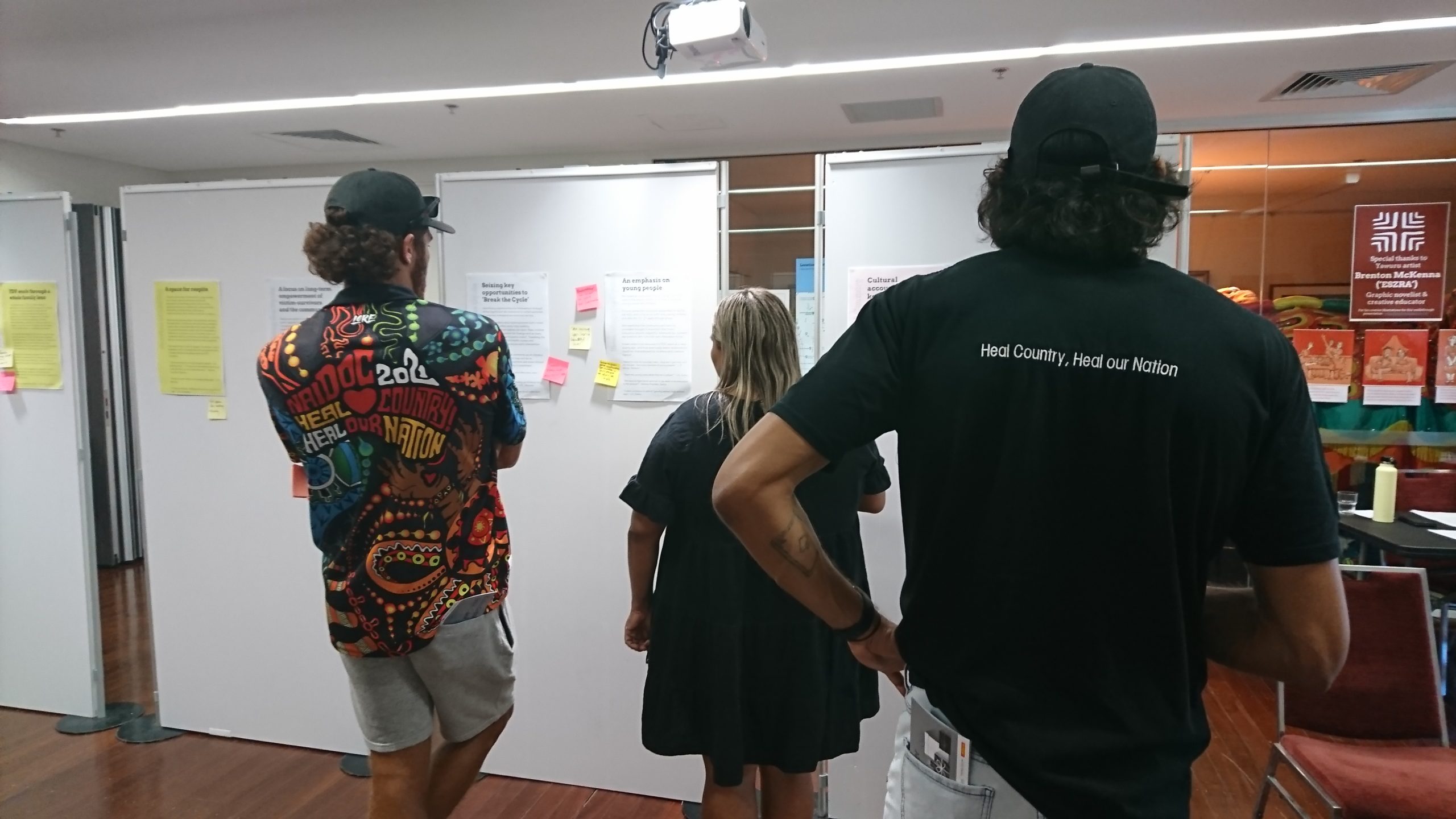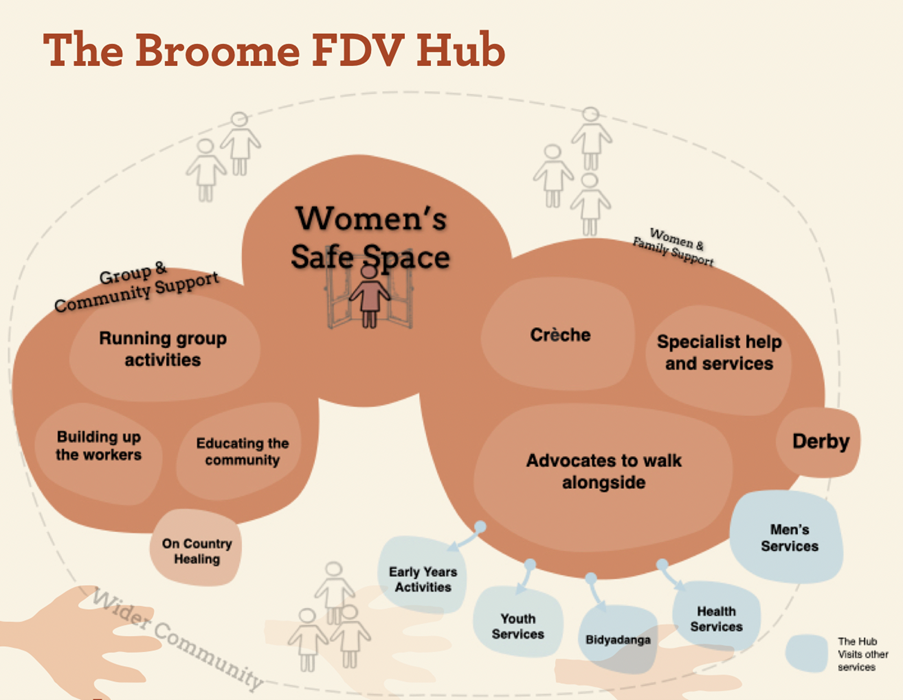
A place based approach to designing FDV Hub services in the Kimberley
blog | Words Zoe O'Neill | 27 Aug 2024
Adapting a service model for FDV hubs in partnership with local communities in the West Kimberley region of Western Australia
The Challenge
In January 2017 the State Government released its Stopping Family and Domestic Violence Policy, which included the initial establishment of two FDV Hubs to simplify access to specialist FDV support services. With a recognition across the sector that some approaches for supporting women and children leaving abusive relationships can be unhelpful and re-traumatising, the Hubs model aims to shift the existing paradigm of support by focusing on primary prevention, early intervention and post- crisis intervention; and was successfully implemented in Mirrabooka (with the Naala Djookan Healing Centre ) and Kalgoorlie (the Mara Pirni Healing Place) in 2020.
In February 2021, the Western Australian Minister for the Prevention of Family and Domestic Violence (FDV) announced plans for additional ‘Hubs’ for FDV support for the Armadale region, and the Kimberley region (later confirmed to be located in Broome). Innovation Unit was commissioned to design and carry out an extensive engagement process with a range of diverse stakeholders to understand the unique context and needs of these communities to ensure the Hub model was driven by perspectives, priorities and aspirations of local people, including those with lived experience of FDV.
While the Armadale Hub provided its own unique suite of place-based considerations, the Broome Hub posed distinct challenges and opportunities given its regional and remote location.
What we did
Innovation Unit undertook a human centred design focus approach to understanding the context in the West Kimberley – specifically Broome, Derby and Bidyadanga.
Our early activities included undertaking desktop research and a literature review as well as developing an initial stakeholder engagement register so that we could learn who the key voices and leaders in the region were. Similarly we understood that while desktop research could provide us with a background, we would need boots on the ground to properly understand the needs and aspirations of the community. We then undertook intensive interviewing on Country to better understand the needs and aspirations of the community, with a particular focus on the voices of Aboriginal victim-survivors and Aboriginal Elders.
Through our initial interviews with service providers, Aboriginal Community Controlled Organisations (ACCOs) and people with a lived experience, we designed further engagements on country – holding mini workshops and focus groups with Aboriginal Elders from different language and cultural groups across the region (including, where appropriate groups of all men, and all women), women with a lived experience of living in local FDV refuges, men and women with a lived experience of FDV and drug and alcohol addiction and rehabilitation, and mothers of young children. These engagements provided us with rich data that we distilled into 16 key insights. Some of these insights included requirements for:
- “A stable, supported, local workforce”
- “In the Kimberley, FDV intersects with poverty”,
- “FDV work in Aboriginal spaces needs to be through a whole of family lens”
- “Cultural accountability as a key ingredient for breaking the cycle”
- “A focus on long-term empowerment of victim-survivors and the community”
- “Seizing key opportunities to ‘Break the Cycle“
- “Complexity in the Kimberley requires flexibility over time”
“The service needs to be able to adapt to a changing landscape over time”
– Service Provider, Broome
These insights were refined and taken back onto Country and were presented to 45+ representatives of the sector to build upon, 50% of whom also identify as having lived experience of FDV. These insights then paved the way for representatives to begin the design of the roles and services that would be needed in the hub, the physical spaces would be appropriate and what enabling conditions would be required for success.
Three draft proposed models emerged, represented by highly visual diagrams. At this stage we also engaged local Yawuru comic artist Brenton McKenna (aka ESZRA) to illustrate vignettes of what key moments of the service might look like (learn more about these illustrations here). These draft conceptual models included suggestions as to the composition of co-located services, required staffing, and resulted in further clarification as to what elements were preferred by the community it was to serve. Community feedback on these models overwhelmingly favoured a ‘FDV through a Family Lens’ model: a model that largely focuses on a family based approach to FDV as well as joining up the existing system. In the comprehensive final report (an overview of which can be found here) the final concept design is illustrated. The report was the foundation of a strong business case for State Government funding of $16.3 million to deliver and operate the service over five years, and further informed the procurement of services to respond to the community priorities.

Impact
The Hub model that emerged from the community consultation and iterative ideation is one that is appropriate, culturally responsive and meets the needs of the existing community while also working to a more aspirational future that breaks the cycle of intergenerational family violence.
We are extremely grateful for the generosity of time, spirit and knowledge provided to us by the many people we were fortunate enough to engage with in Rubibi (Broome) and beyond.
In June 2024, the Department of Communities WA announced the procurement of a consortium of organisations who will lead and rub the Hub service in the Kimberley, taking the West Kimberley one step closer to a valuable service that puts culture, country, community and family at the centre of its work.
Project team
Zoe O’Neill Senior Project Lead (Australia New Zealand)
Jethro Sercombe Director Innovation Practice (Australia New Zealand)
Kaci Oliphant Project Officer (Australia New Zealand)